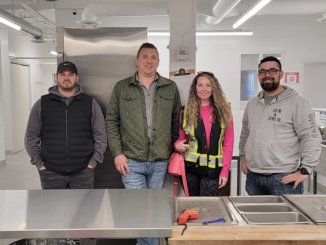
Industry leaders commit to ending substance use stigma and providing support for those in need.
By Natalie Bruckner
On April 14, 2016, British Columbia’s provincial health officer declared a public health emergency in response to a sharp rise in overdose deaths. In the years since, the number of suspected illicit drug toxicity deaths has continued to climb from 994 to 2,272 in 2022, according to the BC Coroners Service—more than half of those who died were employed in the trades and transport industry.

The reason why trades, including sheet metal workers, are more susceptible to substance use challenges hasn’t been widely studied, but Vicky Waldron, executive director at the Construction Industry Rehabilitation Plan (CIRP), believes it is due to the nature of the work. “I think it’s a perfect storm,” she says. “The sheet metal industry is predominantly male, and men don’t like to talk about their emotions. It’s also a very high-pressure industry and physically demanding, working in tight margins with a shortage of workers. Add to that the fact that following an injury the pressure to return to work is significant. You can imagine the drive to say, ‘Well, if I take an opioid or if I take a painkiller, I can mask that pain and get back to work quickly.’ There’s a whole bunch of things that collectively add pressure in this industry.”
Steps Toward Help
The sheet metal industry is well aware of the issue of substance use, but instead of sweeping it under the rug, SMACNA-BC and Local 280, with CIRP’s help, are taking action to tackle the issue at its source to try and prevent those numbers from climbing.
“Many years ago, the building trades in the province got together to create CIRP,” says Richard Mangelsdorf, business manager at Local 280. “Originally, it was a 12-step program with beds for members with addiction challenges. Now, the building is gone, and CIRP has expanded its coverage to include mental health, addictions, and wellness. Over the past few years, Locals started heavily promoting CIRP in an attempt to save lives. Now, more than ever, the drug supply is extremely toxic, and all it takes is one bad batch of drugs and a life or lives can be lost.”
The signatory sheet metal industry has been one of the early adopters of stigma reduction campaigns and efforts to promote mental health awareness. “Because of the work that Jud Martell, training coordinator at the Sheet Metal Industry Training Board, does, some of the highest engagement we see is from the Sheet Metal Workers Training Centre,” Waldron says.
She cautions that higher engagement numbers do not necessarily indicate higher levels of substance use in the sheet metal industry compared to other trades. Rather, they reflect the positive impact of stigma reduction campaigns and support services. “The sheet metal workers have changed the conversation around mental health and substance use,” Waldron says. “Because of that, people feel more confident and safer to actually come forward and ask for help.”
Ending The Stigma
Having made great strides in creating a safe space for workers struggling with substance use and mental health challenges, the industry’s net step—reducing the stigma surrounding these issues—is an ongoing, larger battle that leaders are committed to addressing.
Waldron cites a CIRP and WorkSafe BC study that found while 88 percent of participants were very supportive of someone who may have a mental health and substance use issue, the voice of the remaining 12 percent who are stigmatizing “is far louder.”
“I would hope that some of the stigma has changed around addiction, although I feel that it still has a long way to go,” says Jeremy Hallman, executive director, SMACNA-BC. “Hopefully contractor education programs, like the one we recently offered with CIRP, help drive that message through education and word of mouth.”
Martell explains that the industry takes a multi-faceted approach to open up conversations around substance use and mental health. On day one of technical training, students are reminded of the strict policy against drug and alcohol use and sign an ‘Ability to work’ document. “If a student cannot sign the document, an individual intervention is provided, with the option of directing them to the CIRP, a local union health benefits plan, or union representatives,” he says.
Mangelsdorf adds that substance use and mental health are discussed at every union meeting and apprentice class. The CIRP website is also prominently featured on the footer of every Local 280 website page, and members are referred to the program when they open up about their challenges. “We also discuss it regularly with owners and managers of companies, so they are aware that the programs are available,” says Mangelsdorf.
Strengthening The Approach
When it comes to addressing concerns about a colleague or employee, many people feel unsure of what to do. Waldron’s advice is to approach the conversation with empathy and offer help instead of pointing out behaviours. “Say, ‘Hey, I’ve noticed you’re not yourself recently. What can I do? How can I help you?’”
Hallman says SMACNA-BC’s contractor education session with had one of the highest attendance rates, but there is always more work to be done. Martell and his team have dedicated themselves to education. The Training Centre introduced the new Build Strong app and have made all students aware of its functionality. In addition, the Centre is participating in the A Kit in Every Hand initiative—a pilot program with CIRP that trains workers on harm reduction, overdose prevention, and Naloxone use. “My hopes would be that society at large get to a safe drug supply,” Martell says.
Waldron says continued progress means normalizing conversations around mental health and addictions. “Put up lots of posters around mental health and substance use awareness and set up a mental health committee to talk about it,” she says. “Let people know you understand this is an industry issue and we are all here to support you.”
She emphasises CIRP’s strict confidentiality mandate and the program’s focus on the individuals who come forward for help. “We have a hard wall of silence between us and the employers and the unions,” Waldron says. “The unions are not our clients. The employers are not our clients. Our clients are our clients. We are there for them no matter where they are in their journey.”
Visit CIRP online at https://www.constructionrehabplan.com/ ■



